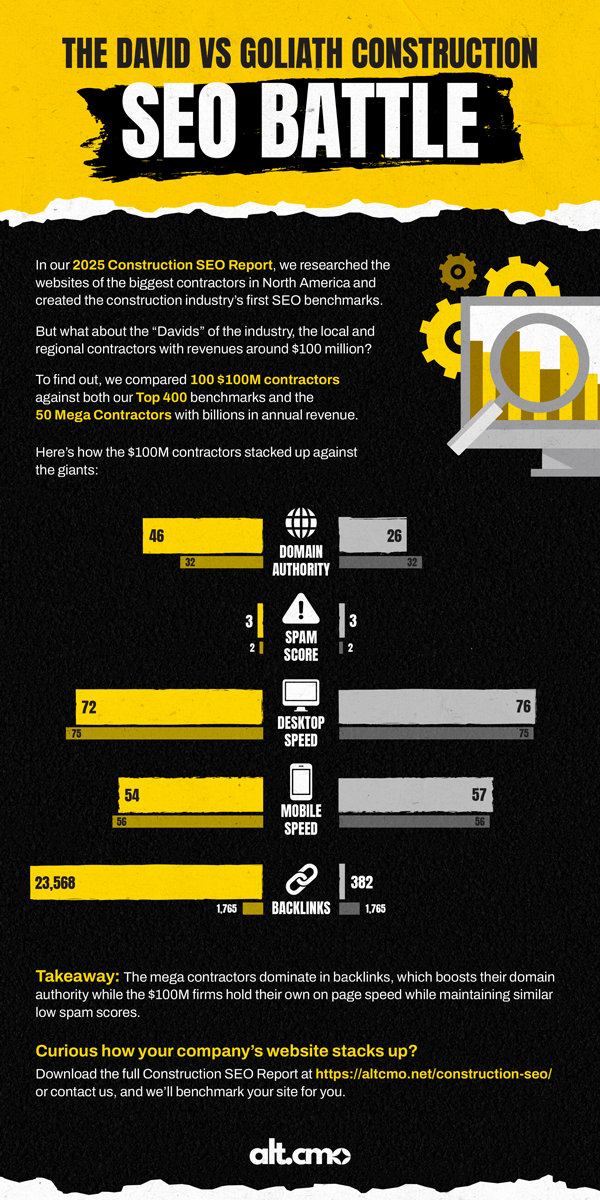I expected mega contractors to dominate SEO. Bigger budgets should mean better digital performance, right?
Not quite.
My recent research, which compared 100 mid-sized construction contractors (≈$100 million in top-line revenue) against the industry’s top 50 giants ($2.6 to $20.2 billion), revealed something counterintuitive. The smaller players are actually winning in critical areas.
The Benchmark Reality
 I started this analysis out of curiosity. After establishing the construction industry’s first SEO benchmarks using the ENR Top 400 contractors, I wanted to see how our typical fractional CMO clients compared.
I started this analysis out of curiosity. After establishing the construction industry’s first SEO benchmarks using the ENR Top 400 contractors, I wanted to see how our typical fractional CMO clients compared.
The ENR 400 had an average domain authority of 32 out of 100. Domain authority is the metric that predicts how likely a website will rank on search engine results pages (SERPs). The higher the score, the higher a website ranks. A domain authority above 30 is considered good for professional services firms, like construction companies.
The 100 mid-sized contractors averaged 26, compared to the 50 mega contractors averaging 46. That’s a significant difference in domain authority.
But here’s where it gets interesting.
The Speed Advantage

Mid-sized contractors websites are faster. On desktop, they averaged 76 compared to the mega contractors’ 72. Mobile showed the same pattern: 57 versus 54.
You’d think that this wouldn’t happen. Bigger budgets typically buy better technical performance.
The culprit appears to be content bloat. Mega contractors load their sites with videos and excessive information, slowing everything down. By the way, page speed has nothing to do with website’s overall size.
Google prefers faster websites because their users want fast loading websites. This gives mid-sized contractors an edge in local SEO searches, especially for longtail keywords with city names or market sectors.
The Local Moat
Consider “commercial construction Denver” or “healthcare contractors Phoenix.” A mid-sized contractor with an actual office in Denver can outperform a mega contractor with just project experience there.
The same applies to suburbs like The Woodlands outside Houston or Naperville, outside Chicago. Physical presence in these areas, a higher concentration of projects in these suburbs, combined with faster page speeds create a powerful competitive moat.
This advantage compounds. With 46% of Google searches being local, and hyper-local searches becoming the new standard, mid-sized contractors can capture high-intent searches that larger contractors often miss because their content is too generic and their lower page speeds aren’t helping them.
The Backlink Reality
Mega contractors still dominate one area: backlinks. They average 23,568 compared to mid-sized contractors’ 382. The industry benchmark for the ENR 400 (which includes the top 50) sits at 1,765 backlinks.
This represents the biggest gap in the data. But it’s not insurmountable.
Quality matters more than quantity in link building. A focused strategy targeting industry publications and local partnerships can close this gap faster than you’d expect.
The Strategic Play
The data reveals a clear path forward for mid-sized contractors. Focus on two areas: maintaining your speed advantage and building quality backlinks.
Don’t fall into the content bloat trap. Keep sites fast and user-focused. The SEO ROI in construction averages 681% with a 7.40 return on ad spend.
Speed plus presence beats size and budget. That’s the lesson from this David versus Goliath SEO analysis.
Your local office, combined with a fast website, creates advantages that no amount of corporate budget can easily replicate. The mega contractors are actually handicapping themselves with their own resources.
Smart mid-sized contractors will recognize this opportunity and act on it. The digital playing field is more level than anyone assumed.

